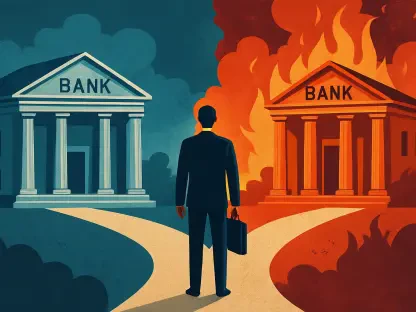Imagine a financial landscape where the drive for economic growth clashes with the scars of past crises, creating a high-stakes balancing act that challenges policymakers and industry leaders alike. In the European Union, proposed changes to securitization rules have ignited a fierce debate among policymakers, regulators, and industry stakeholders. Securitization, the process of bundling loans into securities for sale to investors, remains a controversial tool since its role in the 2007-08 financial meltdown. This roundup dives into diverse opinions on whether these regulatory shifts risk destabilizing Europe’s financial system, gathering insights from various corners to illuminate the complexities and potential consequences of the reforms.
Unpacking Diverse Views on EU Securitization Reforms
The conversation around EU securitization rule changes reveals a spectrum of perspectives, with some viewing the reforms as a vital step toward economic revitalization, while others caution against repeating historical errors. Proponents, particularly aligned with the European Commission’s stance, argue that simplifying regulations will unlock capital for lending, positioning Europe as a stronger competitor against global markets like the United States. This camp sees deregulation as a catalyst for innovation and growth in a post-crisis recovery still lagging behind other regions.
On the other side, regulatory bodies and risk-averse analysts express deep reservations about loosening oversight. Concerns center on the potential for complex, opaque structures to resurface, reminiscent of the deals that fueled past turmoil. The tension lies in whether easing rules will genuinely stimulate lending or merely introduce vulnerabilities, with many stakeholders advocating for a cautious approach that prioritizes long-term stability over short-term gains.
A third viewpoint emerges from industry players who navigate these rules daily, offering a practical lens on the debate. Some financial institutions welcome reduced bureaucratic hurdles but acknowledge the need for clear guidelines to prevent misuse of securitization tools. This pragmatic take underscores a desire for balance, suggesting that reforms should be paired with robust safeguards to avoid systemic pitfalls while still fostering economic activity.
Diving into Specific Concerns and Optimism
Risks of Complexity in Securitization Deals
A significant point of contention among experts focuses on the dangers of intricate securitization structures. Regulatory voices warn that overly complicated transactions, often lacking transparency, could mirror the problematic deals of the late 2000s, potentially destabilizing the financial system. Such concerns emphasize the difficulty in assessing risks when deals involve multiple layers and obscure dependencies, a factor that historically amplified crises.
Industry observers note that while complexity can drive innovation, it also heightens the likelihood of missteps. There’s a shared apprehension that without stringent checks, banks might prioritize profit over prudence, crafting instruments that obscure true risk levels. This perspective calls for standardized frameworks to ensure clarity and manageability in securitization practices.
Contrasting this caution, some market advocates argue that complexity is not inherently negative if paired with adequate expertise and oversight. They suggest that sophisticated structures can distribute risk effectively, provided participants are equipped with the right tools and knowledge. This viewpoint pushes for education and capacity-building as a complement to regulatory adjustments rather than outright restrictions.
Does Deregulation Truly Boost Lending?
Another hotly debated aspect is whether easing securitization rules will achieve the intended goal of spurring lending. Skeptics within regulatory circles question the direct link between relaxed regulations and increased credit flow, pointing out that certain mechanisms, like synthetic securitizations, often fail to generate new funding since loans remain on bank balance sheets. This observation challenges the core rationale behind the proposed changes.
Financial sector analysts add that while capital relief might offer temporary breathing room for banks, it doesn’t guarantee a surge in lending to businesses or consumers. Some argue that broader economic conditions, such as demand for credit, play a larger role than regulatory tweaks. This angle suggests that reforms alone may fall short of expectations without addressing underlying market dynamics.
Supporters of the reforms, however, maintain that freeing up balance sheets, even marginally, creates opportunities for banks to extend credit. They highlight examples from other markets where lighter rules correlated with lending upticks, urging patience as the EU adapts its framework. This optimistic take sees deregulation as a stepping stone, albeit one that requires careful monitoring to ensure positive outcomes.
Transparency and Oversight Challenges
The proposed reduction in due diligence and transparency requirements for private securitization deals sparks varied reactions among stakeholders. Critics from regulatory and academic backgrounds argue that lowering these standards risks fostering less accountable practices, undermining the progress made in financial governance since the last crisis. They stress that opacity in private transactions could hide systemic threats until it’s too late to act.
Some industry insiders echo this concern, noting that diminished transparency might erode investor confidence, ultimately harming the very markets the reforms aim to bolster. There’s a call for maintaining rigorous reporting standards, especially for private deals, to ensure all parties have access to critical risk information. This perspective prioritizes trust as a cornerstone of a healthy financial ecosystem.
On the flip side, a segment of market participants contends that scaling back paperwork and oversight for lower-risk deals could streamline operations without significant danger. They argue that aligning regulatory burden with actual risk levels is a logical step, freeing resources for higher-priority areas. This view pushes for a nuanced approach, suggesting that not all securitization activities warrant the same level of scrutiny.
Economic Goals Versus Historical Caution
The broader clash between economic ambitions and lessons from past crises shapes much of the discourse. Advocates for reform, often aligned with policy-driven growth objectives, emphasize the urgency of stimulating Europe’s economy, particularly in a competitive global landscape. They see securitization as an underutilized tool that, with the right adjustments, could drive significant investment and recovery.
Regulatory and risk-focused perspectives counter this optimism with a reminder of the devastating fallout from unchecked financial innovation in prior decades. There’s a strong push for simpler, more resilient transaction models that minimize the chance of systemic failure, even if it means slower growth. This camp argues that stability must underpin any policy shift, drawing from hard-learned historical insights.
A middle ground emerges from think tanks and advisory groups, suggesting that economic goals and caution aren’t mutually exclusive. They propose a phased implementation of reforms, coupled with real-time assessments to gauge impact. This balanced outlook seeks to reconcile the drive for progress with the imperative to safeguard the financial system, offering a potential path forward amid polarized opinions.
Key Takeaways from the Roundup
Synthesizing the array of insights reveals a nuanced picture of the EU’s securitization rule debate. Regulatory concerns highlight the perils of complexity and reduced transparency, urging a focus on standardized, clear practices. Industry voices offer a mix of optimism for capital relief and pragmatism about the need for safeguards, while policy advocates push for growth-oriented reforms despite acknowledged risks.
For stakeholders, the discussion points to actionable strategies such as prioritizing robust due diligence, even if not mandated, and investing in systems that enhance transparency. Policymakers might consider hybrid approaches that phase in changes while maintaining core protections. Financial institutions are encouraged to balance innovation with resilience, ensuring that short-term gains don’t compromise long-term stability.
This roundup also underscores the value of ongoing dialogue among diverse groups to refine these reforms. Industry players can benefit from engaging with regulatory updates and peer practices to navigate the evolving landscape. Exploring additional resources on financial regulation and market trends can further equip stakeholders to address the challenges and opportunities ahead.
Reflecting on the Debate’s Outcomes
Looking back, the discourse surrounding EU securitization rule changes captured a critical tension between fostering economic growth and preserving financial stability. The range of opinions—from regulatory caution to industry pragmatism and policy ambition—reflected a shared recognition of the high stakes involved. Each perspective contributed to a richer understanding of how past crises continued to shape present decisions.
Moving forward, stakeholders were encouraged to advocate for balanced reforms that integrated transparency and simplicity as non-negotiable principles. Collaborative platforms between regulators and industry leaders emerged as a vital next step to align on practical solutions. Additionally, investing in risk assessment tools and training promised to empower institutions to handle reforms without sacrificing safety, setting a proactive tone for navigating future uncertainties in the EU’s financial framework.









